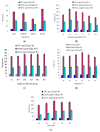Optimization of Ultrasound-Assisted Extraction of Natural Antioxidants from Sugar Apple (Annona squamosa L.) Peel Using Response Surface Methodology
- PMID: 26593890
- PMCID: PMC6332377
- DOI: 10.3390/molecules201119708
Optimization of Ultrasound-Assisted Extraction of Natural Antioxidants from Sugar Apple (Annona squamosa L.) Peel Using Response Surface Methodology
Abstract
Sugar apple (Annona squamosa L.) is a popular tropical fruit and its peel is a municipal waste. An ultrasound-assisted extraction method was developed for the recovery of natural antioxidants from sugar apple peel. Central composite design was used to optimize solvent concentration (13.2%-46.8%), ultrasonic time (33.2-66.8 min), and temperature (43.2-76.8 °C) for the recovery of natural antioxidants from sugar apple peel. The second-order polynomial models demonstrated a good fit of the quadratic models with the experimental results in respect to total phenolic content (TPC, R²=0.9524, p<0.0001), FRAP (R²=0.9743, p<0.0001), and TEAC (R²=0.9610, p<0.0001) values. The optimal extraction conditions were 20:1 (mL/g) of solvent-to-solid ratio, 32.68% acetone, and 67.23 °C for 42.54 min under ultrasonic irradiation. Under these conditions, the maximal yield of total phenolic content was 26.81 (mg GA/g FW). The experimental results obtained under optimal conditions agreed well with the predicted results. The application of ultrasound markedly decreased extraction time and improved the extraction efficiency, compared with the conventional methods.
Keywords: antioxidant; response surface methodology; sugar apple peel; ultrasound-assisted extraction.
Conflict of interest statement
The authors declare no conflict of interest.
Figures





References
-
- Chumnanpaisont N., Niamnuy C., Devahastin S. Mathematical model for continuous and intermittent microwave-assisted extraction of bioactive compound from plant material: Extraction of β-carotene from carrot peels. Chem. Eng. Sci. 2014;116:442–451. doi: 10.1016/j.ces.2014.05.010. - DOI
-
- Fernández-Agulló A., Freire M.S., Antorrena G., Pereira J.A., González-Álvarez J. Effect of the extraction technique and operational conditions on the recovery of bioactive compounds from chestnut (Castanea sativa) bur and shell. Sep. Sci. Technol. 2013;49:267–277. doi: 10.1080/01496395.2013.838264. - DOI
-
- Aila C.M., Naidu K.A., Bhat S.G., Prasada Rao U.J.S. Bioactive compounds and antioxidant potential of mango peel extract. Food Chem. 2007;105:982–988. doi: 10.1016/j.foodchem.2007.04.052. - DOI
-
- Kunradi Vieira F.G., da Silva Campelo Borges G., Copetti C., da Valdemiro Gonzaga L., Costa Nunes E., Fett R. Activity and contents of polyphenolic antioxidants in the whole fruit, flesh and peel of three apple cultivars. Arch. Latinoam. Nutr. 2009;59:101–106. - PubMed
Publication types
MeSH terms
Substances
LinkOut - more resources
Full Text Sources
Other Literature Sources
Medical
Miscellaneous

